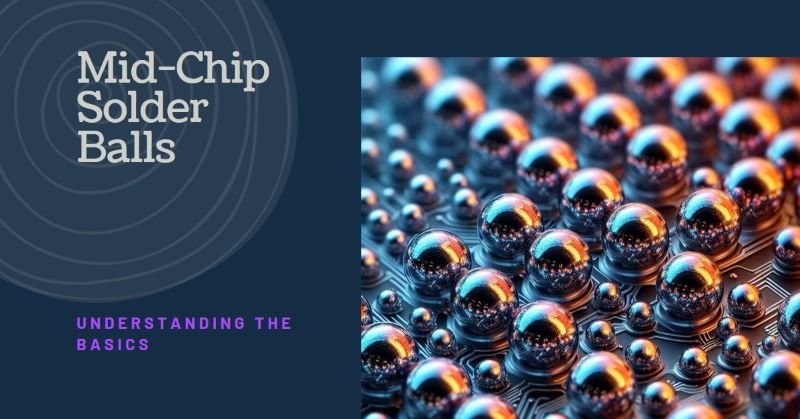What are Mid-Chip Solar Balls?
In the world of PCB (Printed Circuit Board) assembly, achieving optimal performance and reliability is paramount. Among the various technologies used to ensure effective connections and component integrity, mid-chip solder balls have gained significant attention. These specialized soldering elements play a crucial role in the assembly and functionality of advanced electronic devices. Understanding what mid-chip solder balls are and how they are manufactured can provide valuable insights into their benefits and applications in modern electronics.
What are Mid-Chip Solder Balls?
Mid-chip solder balls are small, spherical solder deposits placed strategically in the mid-layer of a multi-layer PCB or within a semiconductor package. Unlike traditional solder balls, which are typically used as part of the package’s external connections, mid-chip solder balls are embedded within the chip or PCB layers. They serve as crucial elements in establishing reliable electrical connections and thermal management within the electronic assembly.
Overview of Their Role in PCB Assembly
Mid-chip solder balls facilitate several essential functions in PCB assembly. They are integral to the process of forming connections between the chip and the PCB, especially in high-density interconnect (HDI) designs. By placing these solder balls within the chip, manufacturers can enhance the reliability and performance of the overall assembly. They also play a significant role in improving thermal dissipation and minimizing mechanical stress on the electronic components.
Manufacturing Process
Description of the Process for Creating Mid-Chip Solder Balls
The manufacturing of mid-chip solder balls involves a precise and controlled process. Initially, solder paste is applied to the designated areas on the chip or PCB. This paste is then subjected to a reflow process, where it is heated to a temperature that allows the solder to melt and form spherical balls. These solder balls are then cooled and solidified, creating the mid-chip connections.
The process must be carefully managed to ensure that the solder balls achieve the correct size, shape, and positioning. Advanced techniques such as stencil printing and selective soldering are often employed to ensure high accuracy and consistency.
Differences Between Mid-Chip Solder Balls and Other Types of Solder Balls
Mid-chip solder balls differ from other solder ball types, such as solder bumps or flip-chip solder balls, in their placement and application. While solder bumps are typically found on the surface of a chip or package and used for external connections, mid-chip solder balls are embedded within the chip or PCB layers. This internal placement allows for enhanced connectivity and thermal management, making them suitable for high-density and high-performance applications.
Applications
Common Applications of Mid-Chip Solder Balls in Electronics
Mid-chip solder balls are commonly used in advanced electronic devices where space is at a premium and performance requirements are high. They are particularly useful in applications involving high-density interconnects, such as in smartphones, tablets, and high-performance computing devices. Their ability to provide reliable connections in compact spaces makes them ideal for use in modern electronics.
Examples of Devices or Components Where They Are Used
Some specific examples of devices and components that utilize mid-chip solder balls include:
- Mobile Processors: High-performance mobile processors often use mid-chip solder balls to ensure reliable connections and efficient heat dissipation.
- Graphics Processing Units (GPUs): GPUs, which require high-density interconnects, benefit from the enhanced connectivity provided by mid-chip solder balls.
- Memory Modules: Advanced memory modules, such as DDR4 or DDR5 RAM, use mid-chip solder balls to improve performance and reliability.
Benefits and Advantages
Benefits of Using Mid-Chip Solder Balls in PCB Assembly
The use of mid-chip solder balls offers several key benefits in PCB assembly:
- Enhanced Connectivity: Mid-chip solder balls provide reliable electrical connections in high-density designs, reducing the risk of connection failures.
- Improved Thermal Management: By enhancing heat dissipation through strategic placement, mid-chip solder balls help prevent overheating and improve device longevity.
- Reduced Mechanical Stress: Their placement within the chip or PCB layers helps distribute mechanical stress more evenly, reducing the risk of damage to sensitive components.
How They Improve Performance and Reliability
Mid-chip solder balls significantly enhance the performance and reliability of electronic assemblies. Their ability to provide robust and stable connections in compact spaces ensures that the electronic devices function efficiently under various operating conditions. Additionally, their contribution to effective thermal management helps maintain optimal operating temperatures, further enhancing the overall performance and longevity of the device.
Challenges and Considerations
Potential Challenges or Issues Associated with Mid-Chip Solder Balls
While mid-chip solder balls offer numerous advantages, their use also presents certain challenges:
- Manufacturing Complexity: The process of accurately placing and soldering mid-chip balls requires sophisticated equipment and tight process control. Any deviations can lead to issues like misalignment or insufficient solder, affecting the quality of the final product.
- Cost Implications: The additional steps required for mid-chip solder ball placement can increase manufacturing costs. This includes the costs of advanced equipment and higher precision in the assembly process.
- Thermal Management: While mid-chip solder balls improve thermal dissipation, the design must be carefully managed to ensure that the heat is effectively spread and does not lead to hotspots within the device.
Considerations for Their Effective Use
To effectively use mid-chip solder balls, consider the following factors:
- Design Specifications: Ensure that the PCB and chip designs are optimized for the placement and use of mid-chip solder balls. This includes accurate design of solder pads and alignment features.
- Quality Control: Implement rigorous quality control measures to detect and address any issues during the manufacturing process. This includes monitoring solder ball placement and reflow processes.
- Thermal Management: Design the PCB layout to facilitate effective heat dissipation. This may involve using additional thermal management techniques in conjunction with mid-chip solder balls.
Industry Standards and Best Practices
Relevant Industry Standards for Mid-Chip Solder Balls
Several industry standards and guidelines are relevant for mid-chip solder balls, including:
- IPC Standards: The IPC (Institute for Interconnecting and Packaging Electronic Circuits) standards, such as IPC-610 for acceptability of electronic assemblies, provide guidelines on soldering practices, including those for solder balls.
- JEDEC Standards: JEDEC (Joint Electron Device Engineering Council) standards, such as JESD22 for component stress testing, outline requirements for solder ball performance and reliability.
- ISO Standards: ISO (International Organization for Standardization) standards related to quality management and electronics assembly also apply to the use of mid-chip solder balls.
Best Practices for Their Implementation in PCB Designs
To ensure optimal performance and reliability when using mid-chip solder balls, follow these best practices:
- Precision Placement: Use advanced placement and soldering techniques to ensure that mid-chip solder balls are accurately positioned and properly soldered.
- Thermal Analysis: Conduct thorough thermal analysis during the design phase to ensure that mid-chip solder balls effectively manage heat dissipation.
- Regular Inspection: Implement regular inspection and testing procedures to identify any issues early in the manufacturing process and ensure that the solder balls meet quality standards.
- Documentation and Training: Maintain detailed documentation of the processes and provide training for personnel involved in the assembly and inspection of PCBs with mid-chip solder balls.
Conclusion
In summary, Mid-chip solder balls are a critical component in modern PCB assembly, offering enhanced connectivity and improved thermal management in high-density designs. Their precise manufacturing and placement are crucial for achieving the desired performance and reliability. Despite the challenges, such as increased complexity and cost, the benefits of using mid-chip solder balls make them a valuable technology in advanced electronics.
FAQ
Q1: What are mid-chip solder balls used for?
Mid-chip solder balls are used to create reliable electrical connections and improve thermal management within multi-layer PCBs and semiconductor packages. They are particularly useful in high-density electronic designs.
Q2: How are mid-chip solder balls manufactured?
Mid-chip solder balls are manufactured by applying solder paste to designated areas, followed by a reflow process where the solder melts and forms spherical balls. The solder is then cooled and solidified to create the connections.
Q3: What are the main benefits of using mid-chip solder balls?
The main benefits include enhanced connectivity in high-density designs, improved thermal management, and reduced mechanical stress on electronic components.
Q4: What challenges are associated with mid-chip solder balls?
Challenges include manufacturing complexity, increased costs, and the need for effective thermal management. Ensuring precise placement and high-quality soldering is crucial to overcoming these challenges.
Q5: What industry standards apply to mid-chip solder balls?
Relevant industry standards include IPC standards for soldering practices, JEDEC standards for component stress testing, and ISO standards for quality management and electronics assembly.








